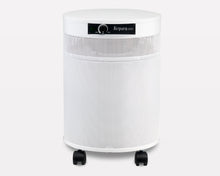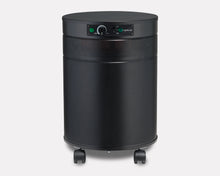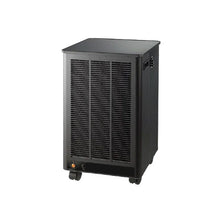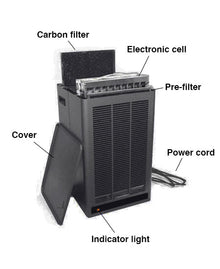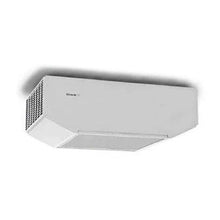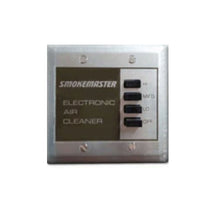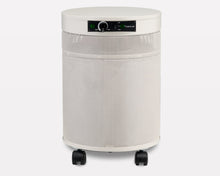The Science of Smell: How Activated Carbon Filters Target and Eliminate Smoke Odors
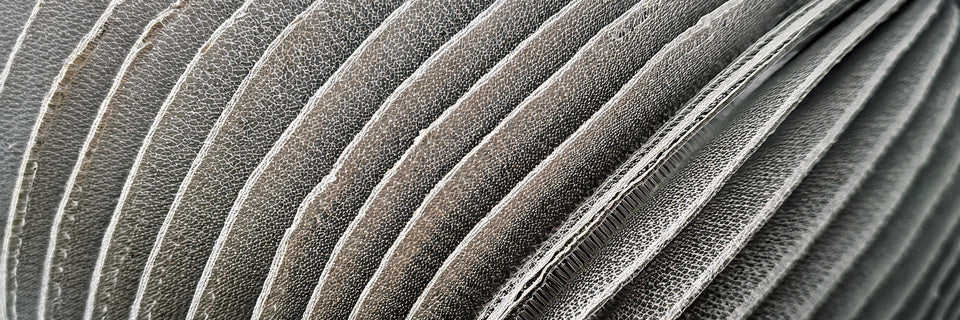
Do you ever walk into a room and instantly know someone was smoking? Whether it’s the lingering scent of a cigar from last night's gathering, the unmistakable aroma of cannabis, or the sweet but heavy notes of hookah, smoke odors have a way of clinging to everything—furniture, clothes, and even the very air itself. These smells aren't just an annoyance; they're a complex chemical problem. For anyone who has tried to get rid of them with sprays or open windows, the frustration is real. But what if there was a way to do more than just mask the smell? What if you could actually pull those microscopic odor molecules right out of the air? 💨 Commercial Air Purifiers, LLC is here to break down the science of how activated carbon filters provide a powerful, lasting solution to this pervasive issue.
The Chemistry of Stale Smoke: Why the Smell Just Won't Quit
To understand how to get rid of smoke odors, you first have to understand what they are. Smoke, from any source, is not just a uniform gas. It’s a complex mixture of thousands of different chemical compounds, many of which are volatile organic compounds (VOCs) and tiny particles. When we breathe in the smell of smoke, we’re actually inhaling these minuscule compounds. Think of them as microscopic building blocks of odor. When a cigarette, cigar, or hookah is lit, combustion releases these molecules into the air. They are incredibly small and light, which allows them to travel and embed themselves in porous surfaces like upholstery, carpets, and drywall. This is why airing out a room often doesn't work; the scent molecules have already been absorbed into the furnishings and are slowly off-gassing, or being released back into the air, over a long period. This constant reintroduction of odor is what makes the smell so persistent and difficult to eliminate.
This phenomenon is more than just an inconvenience; it can have health implications. The U.S. Environmental Protection Agency (EPA) has highlighted that secondhand smoke contains more than 7,000 substances, hundreds of which are toxic, and at least 69 are known to cause cancer. Even thirdhand smoke—the residue that clings to surfaces—can release harmful compounds. While most people are aware of the health risks of inhaling secondhand smoke, the insidious nature of thirdhand smoke is a growing concern. A 2020 study published in the journal Science Advances investigated how thirdhand smoke components can react with common indoor pollutants to form new, even more harmful substances. This is a powerful reminder that the odor we smell is a symptom of a deeper air quality problem.
How Activated Carbon Filters Work: Adsorption is Key
When you’re dealing with something as stubborn as smoke, you need a solution that goes beyond just trapping particles. That’s where activated carbon comes in. It's not just a filter; it's a chemical sponge. At the heart of this technology is a process called adsorption. It’s a common point of confusion, but adsorption is different from absorption. With absorption, one substance is absorbed into another, like a sponge soaking up water. With adsorption, molecules stick to the surface of a material. Activated carbon is specially processed to have an incredibly porous surface with a massive internal surface area. A single pound of activated carbon can have a surface area equivalent to several football fields. This is what allows it to be so effective at capturing and holding onto odor molecules.
The process of creating activated carbon involves heating a carbon-rich material—like coconut shells or wood—to extremely high temperatures in a low-oxygen environment. This creates a porous charcoal structure. The charcoal is then "activated" by injecting steam or other gases, which etches away at the carbon and creates a network of microscopic tunnels and pores. This is the crucial step that supercharges its ability to adsorb. When air contaminated with smoke odors passes through the filter, the VOCs and other gaseous molecules are drawn into these pores and stick to the carbon's surface, effectively removing them from the air.
Our years of experience at Commercial Air Purifiers, LLC, have taught us that not all carbon filters are created equal. The key to true odor elimination is using a high-quality, dense carbon filter. A thin, flimsy filter with a small amount of carbon won't be able to handle the high volume of odor molecules found in a smoke-heavy environment. This is where a robust and thoughtfully designed air purifier makes all the difference. For example, a HEPA filter alone—while excellent for trapping particulate matter like ash—is ineffective against gaseous odors. This is why a combined approach is necessary, and why we’ve always focused on systems that pair an effective HEPA filter with a substantial activated carbon filter. This dual-filtration approach tackles both the solid particles and the gaseous compounds that create smoke's signature smell.
Case Study: A Personal Story of Odor Elimination
We've seen countless success stories from our customers, and a common theme is the almost immediate relief they feel when the lingering smell is gone. One of our customers, a small business owner who runs a cigar lounge, had an ongoing battle with the persistent scent of cigars. Despite having a powerful ventilation system, the smell would cling to the walls, furniture, and even the staff's clothing. He had a few small air purifiers in the lounge, but they were only making a minimal impact on the odor.
We worked with him to install a high-capacity commercial air purification system with a deep-bed activated carbon filter. Within a few days, he noticed a dramatic improvement. The stale, heavy odor was gone, replaced by a clean, fresh smell. He told us, “Before, when a new customer came in, they'd comment on the smell. Now, they just say the air feels so much cleaner.” This isn't an isolated case. From cannabis grow operations to hookah bars, we’ve found that the right activated carbon system provides a level of odor control that traditional methods simply can’t match. It’s the difference between masking an odor and truly removing it. This first-hand experience and direct feedback from people on the front lines of air quality challenges continually reinforces our commitment to the science of activated carbon filtration.
Navigating Your Options: Selecting the Right Air Purifier for Smoke
When you’re looking for a solution to smoke odors, it's important to know what to look for. Not all air purifiers are designed to handle this specific challenge. Here are some key factors to consider:
-
Filter Type: Look for a purifier that explicitly includes an activated carbon filter. A HEPA-only filter will not remove the odors. Some purifiers have a pre-filter to catch larger particles before they reach the main filters, which helps extend the life of the HEPA and carbon filters.
-
Carbon Weight: This is a critical but often overlooked metric. The more activated carbon a filter contains, the more odor-causing molecules it can adsorb. For heavy smoke environments, a system with a few pounds of carbon is far superior to a small filter that contains only a few ounces. A product description that touts a "carbon pre-filter" is often a red flag, as these are typically too thin to be truly effective against heavy odors.
-
Airflow and CADR: The Clean Air Delivery Rate (CADR) measures how much clean air a purifier produces per minute for specific pollutants like smoke, pollen, and dust. For smoke, a high CADR number indicates that the purifier can process the air in a room quickly and effectively. A higher CADR is crucial for rooms with consistent smoke production, as it ensures the odor molecules are captured before they have a chance to settle.
-
Room Size: Always choose an air purifier rated for the size of your room. An air purifier that is too small for the space will not be able to cycle the air frequently enough to keep up with the odor source.
These are the same principles we use when designing our own commercial air purifiers. We prioritize a deep carbon bed and a powerful fan because we know these two components are non-negotiable for effective odor removal. For environments with smoke from cigars, cannabis, or hookah, a combination HEPA and granular activated carbon filter is the gold standard for removing both particulate matter and gaseous odors.
Conclusion: Breathe Easy, the Science is Here
The battle against smoke odors can feel endless, but the science of activated carbon filtration offers a powerful and permanent solution. It's not about covering up a smell; it's about using the fundamental principles of chemistry to remove the odor-causing molecules from the air entirely. From the persistence of thirdhand smoke to the effectiveness of a dense carbon filter, we've explored the core concepts behind this technology. At Commercial Air Purifiers, LLC, we believe that understanding the science is the first step toward a healthier, more pleasant environment. Our goal is to provide the tools and knowledge you need to take control of your indoor air quality. By choosing a high-quality air purifier with a robust activated carbon filter, you're not just buying a machine; you’re investing in the science of clean air.
Frequently Asked Questions
Q: Can a regular HEPA air purifier remove smoke smells?
A: No, a regular HEPA air purifier is designed to capture solid particles like smoke ash, dust, and pollen. It is not effective at removing the gaseous molecules (VOCs) that cause smoke odors. For effective odor removal, an activated carbon filter is essential.
Q: How often do I need to replace the carbon filter?
A: The lifespan of a carbon filter depends on the amount of pollution it's exposed to. In a consistently smoky environment, the filter will become saturated faster than in a clean one. For heavy use, you may need to replace it every 3 to 6 months. Most air purifier manufacturers provide guidelines, and some models have indicators to let you know when a filter change is needed.
Q: What is the difference between an air purifier and a simple air freshener?
A: An air freshener simply masks odors by releasing a fragrance into the air, but it does nothing to remove the odor-causing molecules. An air purifier, especially one with activated carbon, actively removes these molecules from the air, providing a true and lasting solution to the odor problem.
Q: Does activated carbon work on all types of smoke odors?
A: Yes, activated carbon is effective on a wide range of gaseous pollutants, including those from cigar, cannabis, and hookah smoke. The science of adsorption applies universally to most VOCs, making it a versatile solution for various smoke types.
Q: Is there any specific maintenance required for air purifiers that handle smoke?
A: Regular maintenance, such as replacing the activated carbon and HEPA filters according to the manufacturer's recommendations, is crucial. If a pre-filter is present, cleaning or replacing it will help extend the life of the other filters. Keeping the intake vents free of dust and debris also ensures optimal airflow.
Author Bio: This article was written by the team at Commercial Air Purifiers, LLC. We are passionate about creating cleaner, healthier indoor environments. Our expertise is built on years of experience in the air quality industry, and we are committed to providing transparent, science-backed solutions for our customers. For more information on air quality and our products, please visit our website.
Publication Date: September 7, 2025
Sources:
-
National Institute of Environmental Health Sciences, "Thirdhand Smoke," https://www.niehs.nih.gov/health/topics/agents/thirdhand/index.cfm
-
Sleiman, M., et al. (2020). "Chemical transformations of nicotine and other thirdhand smoke pollutants on indoor surfaces." Science Advances, 6(39), eabc6938.
-
U.S. Environmental Protection Agency, "Health Effects of Secondhand Smoke," https://www.epa.gov/tobacco-smoke-and-health/health-effects-secondhand-smoke

